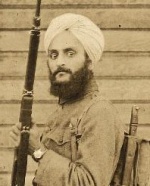United States v. Bhagat Singh Thind

United States v. Bhagat Singh Thind, 261 U.S. 204 (1923), was a case in which the United States Supreme Court decided that Bhagat Singh Thind, who was a Punjabi Sikh, settled in Oregon, could not be a naturalized citizen of the United States, because he was not a "white person" in the sense intended in the relevant 1790 statute governing naturalization.
Although Thind argued that as an Indian he belonged to the Aryan and therefore the Caucasian race, the Court found that "the Aryan theory, as a racial basis, seems to be discredited by most, if not all, modern writers on the subject of ethnology," and noted that "the Caucasic division of the human family is 'in point of fact the most debatable field in the whole range of anthropological studies.'" The Court found that the authors of the 1790 statute probably ascribed to "the Adamite theory of creation" and understood "white people" in its popular, and not scientific, sense.
The bench
Opinion
According to the Court, "Congress, by the Act of February 5, 1917, 39 Stat. 874, c. 29, § 3, has now excluded from admission into this country all natives of Asia within designated limits of latitude and longitude, including the whole of India." Bhagat Singh Thind claimed the right to citizenship as a white person, following the original naturalization statute of 1790. The Court concluded that the 1917 statute applied to Bhagat Singh Thind and thus supported the revoking of his citizenship, per the request of the Naturalization Examiner (who had originally objected to his being granted citizenship).
Associate Justice wikipedia:George Sutherland found that, while Thind, an Asian Indian, may claim to have "purity of Aryan blood" due to being "born in Village Taragarh Talawa,near Jandiala Guru, Amritsar, Punjab" and having "high caste" status; he was not Caucasian in the "common understanding", so he could not be included in the "statutory category as white persons".[1] George Sutherland wrote in his summary: [1]
| The eligibility of this applicant for citizenship is based on the sole fact that he is of high caste Hindu stock, born in Punjab [Amrit Sar], one of the extreme northwestern districts of India, and classified by certain scientific authorities as of the Caucasian or Aryan race...In the Punjab and Rajputana [Rajasthan], while the invaders seem to have met with more success in the effort to preserve their racial purity, intermarriages did occur producing an intermingling of the two and destroying to a greater or less degree the purity of the “Aryan” blood.
The rules of caste, while calculated to prevent this intermixture, seem not to have been entirely successful... the given group [Asian Indian] cannot be properly assigned to any of the enumerated grand racial divisions. The type may have been so changed by intermixture of blood as to justify an intermediate classification. Something very like this has actually taken place in India. Thus, in Hindustan [India] and Berar [town in India] there was such an intermixture of the “Aryan” invader with the dark-skinned Dravidian.[1] |
The Court concluded that "The term 'Aryan' has to do with linguistic, and not at all with physical, characteristics, and it would seem reasonably clear that mere resemblance in language, indicating a common linguistic root buried in remotely ancient soil, is altogether inadequate to prove common racial origin."
Background
Not only were Indians denied the ability to naturalize, their new classification as Asian, rather than white, allowed the retroactive stripping of previously naturalized Indians of their American citizenship, because zealous prosecutors argued that Indian Americans had gained citizenship illegally, a claim often upheld. Moreover, without citizenship, Indian land owners fell under the net of the California Alien Land Law and other racist laws spearheaded by growing hatred against Asian immigrants.
Specifically, Attorney General wikipedia:Ulysses S. Webb was very active in revoking Indian land purchases; in a bid to strengthen the AEL, he promised to prevent Indians from buying or leasing land. Under intense pressure, and with The Barred Zone Act of 1917 preventing fresh immigration to strengthen the fledgling Indian-American community, most Indians left the United States, leaving only half their population, 2,405, by 1940.
Aftermath
As a result of a U.S. Supreme Court decision stipulating that no person of East Indian origin could become a naturalized American, the first person of Indian origin to become an American citizen, A.K. Mozumdar, had his citizenship revoked. A decision on his appeal to the Ninth Circuit Court of Appeals upheld that revocation.
Suggestive of the poor coordination within the legal system of the early 20th century is the fact that Thind applied for and received U.S. citizenship through the state of New York a few years after his original U.S. citizenship was revoked by the U.S. Supreme Court. Numerous other instances exist of naïve clerks, or clerks acting in protest, who granted citizenship in defiance of the Supreme Court[citation needed].
As public support for Indians grew throughout World War II[citation needed], and as India's independence came closer to reality, Indians argued for an end to their legislative discrimination. The repeal of Chinese exclusion laws in 1943 and the granting of naturalization privileges to Chinese encouraged Indians to hope for similar gains. Hurdling over many members of Congress and the American Federation of Labor, which vehemently opposed removing legislative measures barricading Indian immigration and naturalization, the Indian community succeeded in gaining support among several prominent congressmen, as well as President Franklin D. Roosevelt.
The support culminated in the signing into law by President Truman on July 2, 1946, of the Luce-Celler Act. This Act reversed the Thind decision, insofar as allowing naturalization to Indians, and set a token quota for their immigration at 100 per year.
In 1965, President Lyndon Johnson signed the Hart-Celler Immigration Act, which phased out the national origins quota system first instituted in 1921. In 1965–1970, 27,859 Indian immigrants entered the United States. Immigration from India in 1965–1993 was 558,980.[citation needed]
